How to make garden drainage with your own hands: analysis of arrangement technology
Not all owners of suburban estates are "lucky" with ideal hydrogeological conditions. Often only in the process of cultivating the land or building they understand that groundwater lies high, that puddles stand for a long time during the flood period. Do not worry, this problem will eliminate the drainage. Agree, it is much easier to build it than to look for a perfect site.
The drainage system will relieve excess moisture of the soil-vegetable layer, which will ensure the normal growth of cultivated green spaces. It will divert underground water from the foundation in case of contact, protect the basement and the inspection pit of the garage from flooding.
Those wishing to arrange the drainage of the garden site with their own hands or the efforts of the brigade of landscape workers, we will find detailed answers to all kinds of questions. Our material describes in detail the options for groundwater drainage systems and how to construct them.
The content of the article:
Prerequisites for the construction of drainage
A drainage system that collects and discharges excess groundwater is necessary in the following cases:
- The plot is flat, i.e. There are no conditions for spontaneous movement of water downhill.
- Groundwater is noted at a level close to the surface of the earth.
- The site is located in a lowland, river valley or in a marsh drained area.
- The soil and plant layer develops on clay soils with low filtration properties.
- The summer house was built on a slope, not far from its foot, due to which, when precipitation falls on and around the site, water accumulates and stagnates.
Installation of drainage is almost always necessary in areas with clay soils that underlie the soil: sandy loam, loam. During the period of heavy rainfall and snowmelt, this type of rock passes water too slowly through its thickness or does not allow it to pass at all.
Water stagnation at the level of soil development is associated with its overmoistening. In a humid environment, fungus actively multiplies, infections, pests (slugs, snails, etc.) appear, which leads to diseases of vegetable crops, rotting of the roots of bushes, perennial flowers and trees.
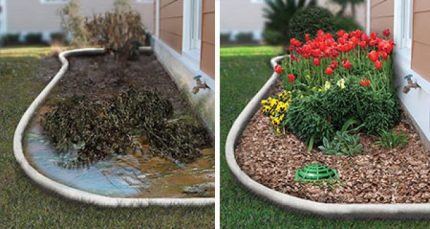
If you do not solve the problem of waterlogging of the soil, then over time, erosion of the earth may occur. In frosty times, water-containing soil layers will heave, which may damage the foundation, paved walkways and other landscaping facilities.
To check if drainage is needed, you need to know the throughput of the soil layers in the area. To do this, dig a small pit 60 cm deep and pour water to the limit.
If water is absorbed per day, then the soil underlying the soil has acceptable filtration properties. In this case, there is no need for drainage. If after two days the water does not leave, it means that clay rocks lie under the soil and plant layer, and there is a risk of overmoistening.
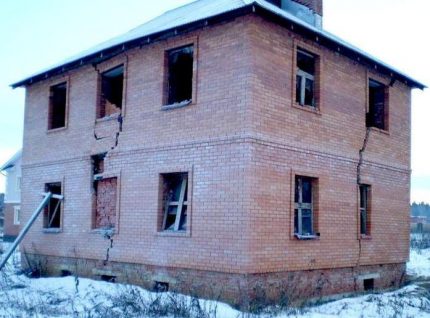
If not timely introduce a drainage system, then the following problems threaten suburban possessions:
- flooding of cellars, ground floors, additional buildings located below ground level - this subsequently leads to damage to wall materials, the formation of mold and fungi, rotting of furniture, stairs and other wooden structures;
- waterlogging of the soil due to its saturation with moisture, which leads to low productivity, decay of the roots of vegetable crops, plants, the death of trees and other plantings;
- dips, depressions, pits can form on the site, as a result of which paved paths and tiles are destroyed - all this negatively affects the landscape of the infield.
In winter, during the freezing of ORS and underlying heaving soils lying above the level of seasonal freezing, the water contained in the pores of the earth will expand. An increase in the volume of soil threatens with the destruction of structures buried in it and resting on the ground.
The organization of the drainage system will allow the most simple and affordable way to solve the following problems:
Consider the types of drainage systems and their features.
The main types of soil drainage systems
Before you begin to engage in the preparation of a work plan, the purchase of equipment and materials, you need to determine which system is appropriate to implement, so that it works as efficiently as possible.
There are three types of drainage systems:
- superficial (open) - is a ditch on the surface of the earth, used to remove excess moisture formed due to private rains or melting snow;
- deep (closed) - water drainage is carried out using a system of pipes, wells; the system is used in case of a risk of flooding the garden with rainfall and / or groundwater;
- filling - the principle of its construction is the same as the deep one, only drainage material without pipes is used exclusively; Suitable for drainage during precipitation.
Each of the above technologies has its advantages and disadvantages.
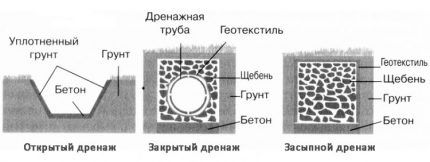
The surface drainage network is often combined with storm sewers, collecting and discharging precipitation. The stormwater is equipped with two types of water collectors: point and linear.
Stormwater as an effective supplement
Storm sewer - a set of drainpipes with a well for the accumulation of moisture through which it is transferred to the water intake. Before entering the water in the well, there is a special siphon partition (grate) designed to clean the incoming liquid from debris, as a result of which the system does not become clogged, and there is no unpleasant odor in it.
Storm sewage system with linear water collectors is a series of trays located at a slope towards the place of moisture collection. Tanks are installed in ditches with a layer of gravel at the bottom. The technology is used when the slope of the daily surface of the site does not exceed 30 degrees relative to the horizon.
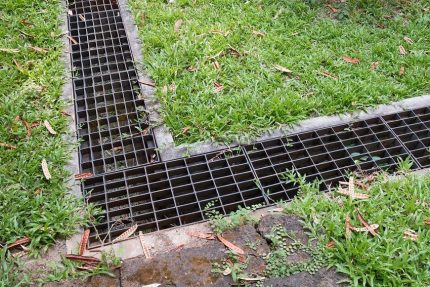
The main difference between a point system and a linear one is that a point system uses a pipe system located underground. Water collection occurs through the so-called “points” - special storm drains equipped with a permeable grate.
This solution makes the design almost invisible on the site.
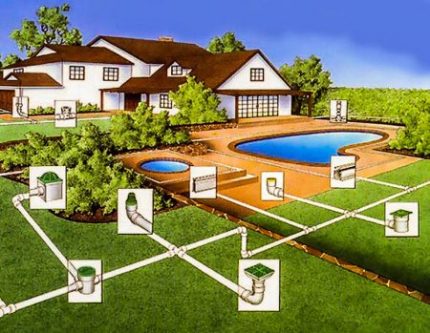
Sometimes systems of the same type are not enough for the territory, therefore, to maintain the optimum level of moisture, they can be combined.
It is necessary to select the type of system individually, taking into account landscape, geological features. For example, if the house is located away from the reservoir, then you can restrict yourself to open drainage. If the mansion is located on a landslide hazardous slope in a river valley, then it is better to use several systems at the same time. You can read more about the arrangement of storm sewers here.
Closed drainage device
The closed-type system is a network of trenches in which pipes and drainage material are laid. Drainage can be laid both over the entire area and in a specific area that needs a drainage system.
The deep drainage system consists of the following elements:
- drainage pipes;
- well (drainage system);
- pump for pumping water.
To implement the system, it is necessary to dig trenches, install pipes, and construct drainage systems.
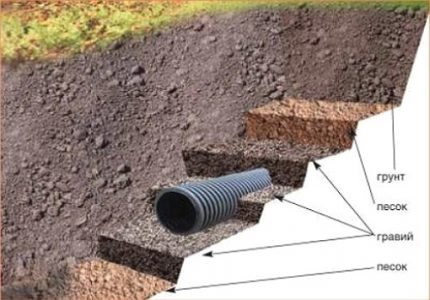
To equip the water supply in the trench you will need:
- geotextiles;
- crushed stone;
- gravel;
- sand.
The system is effectively used in case of flooding of the site with groundwater.
Standard structural components of the drainage system are:
Drawing up the layout of elements
Before carrying out the work, it is necessary to draw up a plan of the site, noting the objects of housing, household and household purposes, as well as shrubs, trees, flower beds.
Next, you need to determine the location for the well, taking into account the location of the drainage system. A drain can be a sewer, a well, or any other natural source of water.
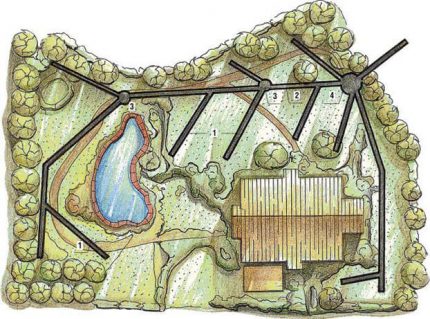
Then you need to make an arrangement of the trenches.
There are 4 main types of circuits:
- location by a snake;
- parallel device;
- laying herringbone drains;
- trapezoid location.
You can choose the scheme yourself, but the most commonly used is herringbone markup.
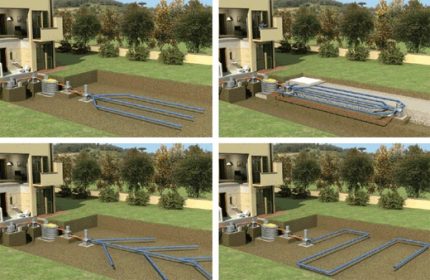
Ditches can be located around the perimeter of the territory and along the contour of the house. On the site where vegetables, flowers and flowers will grow, a network is being built taking into account the requirements, which will be discussed below.
Installation Specifications
When building a trench, the following requirements must be considered:
- depth should be 1-1.2 m, and width - 35-40 cm;
- near the trees a trench is dug to a depth of 1.2-1.5 m, near forest stands - 70-90 cm, near flower beds - 60-80 cm;
- if peat soil prevails at the PRS level of the site, then, given that it quickly shrinks, the depth of the trench should not be less than a meter;
- if the site is embossed, then the depth can reach a meter, if it is gentle or with a slight slope, then digging a trench with a depth of less than 1.5 m is inefficient;
- on clay soils: sandy loam, loam, trenches are dug at a distance of 7-10 m from each other, on well-drained: sand, gravel and gravel deposits - 15-20 m;
- The drainage system should be located further than 1 meter from the foundation of the house, and the minimum permissible distance to the fence is 50 cm.
For the construction of an open drainage system, special pipes with a mesh should be selected. Their diameter can vary from 0.15 to 0.5 cm. It is better to refuse to use asbestos-cement or ceramic drains, since they are impractical, require preliminary preparation, frequent washing, and quickly become clogged.
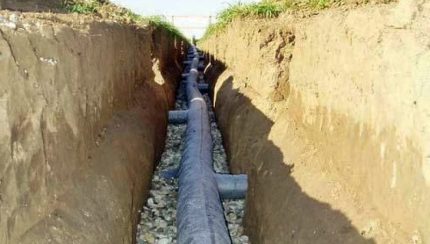
For the installation of closed drainage branches, it is recommended to give preference to perforated pipes made of polymer or composite materials. Some modifications are equipped with a special filter shell (geotextile), which prevents clogging of the system.
The diameter of the manifold must be larger than the diameter of the pipe. If the area of the plot being equiped is more than 0.5 ha, then the diameters may be equal.
The slope of the system towards the collector should be 2-3 cm per meter of pipe with a diameter of 5-10 cm. If it is planned to use a pipe of a larger diameter, the slope should be less. In more detail about how to correctly calculate the slope of the drainage pipe, we set out in this material.
Landowners in a lowland or on a steep slope face a problem when the water stagnates in the lowest place, when, as a water intake, it can be located higher. In this case, in the lower part of the territory it is necessary to build a storage well into which it is necessary to introduce a drainage pump. With its help, water is pumped up with a discharge into a ditch, ravine or other water receiver.
If it is planned to build an absorption well on the site for disposal of the collected water, then the work on its construction is carried out in the following sequence:
System construction progress
The first thing to do before digging a trench is build a drainage well. Its depth should be 2-3 m and a diameter of up to 1 meter.
The most reliable well is concrete. However, installing concrete rings manually is not always possible, so you will have to resort to the help of lifting equipment. In addition, high cost and fragility are disadvantages of concrete structures.
Plastic well - a special design made of polyethylene, polypropylene or polyvinyl chloride, is practical and high quality, effectively withstands soil pressure. The advantage of a reservoir well is that it provides pipe bends, and comes with rubber cuffs to ensure tight joints.
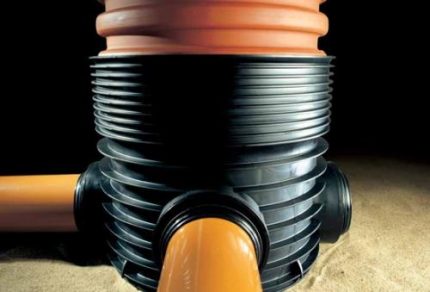
You can also pave a brick well yourself, make a structure of rubber and other improvised materials.
The well is subsequently installed drainage pump, which pumps water to a drainage system - a sewer, a well or other natural water intake.
Then you can start digging trenches according to the scheme, taking into account technical requirements.
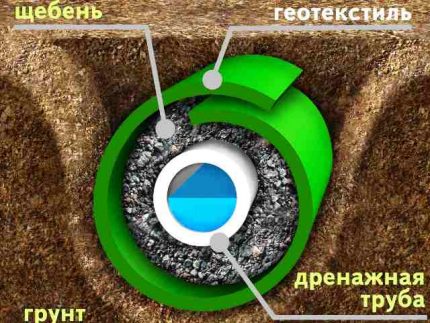
To protect against clogging of ordinary plastic pipes, so-called “external” filters are used, made of straw, fiber peat, and weaving waste.
After digging the trenches, perform the following actions:
- They fill the trench with sand at 10 cm, after which they adjust the geotextile layer so that the edges of the canvas are higher than the recess.
- Geotextile is covered with crushed stone by 20 cm.
- Lay drainage pipes.
- Pipes are covered with gravel or gravel of sedimentary rocks to a height of 30-40 cm, then with coarse or gravelly sand at 30 cm.
- Folding geotextiles - it will hold small particles and allow the system to clog.
- Geotextiles are sprinkled on top with a fertile layer of earth - soil.
- Pipes are connected to the well.
The technology for designing a system of backfill drainage differs from the deep one in that pipes are not provided in it. Trenches are filled with large gravel or broken brick, and they are covered with fine stone or gravel on top.
Open option implementation
To create surface systems, the same trench construction rules are used as for the deep ones.
For an open system, it is enough to build ditches with a depth of 0.7 m and a thickness of 0.5 m. The walls are made with a slope, the bevel angle is 30 degrees. The ditch is led into a sewage well, which is common to sites or to any other water intake.
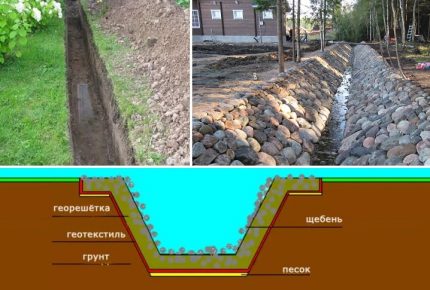
The walls of the open drainage ditches are compacted, sometimes reinforced with cobblestone or rubble stone, laid out with concrete tiles.
On our site there are other materials about the arrangement of the drainage system on the site and around the house, we suggest you familiarize yourself with them:
- Drainage device around the house: design and installation of a drainage system with your own hands
- Drainage scheme around the house: the nuances of designing drainage systems
- How to make your own foundation foundation house drainage: the secrets of proper organization
- Site drainage project: design rules + selection of location, slope, depth, system elements
Extension of drainage service life
The sump type drainage system is able to function effectively for 5-7 years, when both deep and open drainage structures with high-quality pipes make it possible to forget about the problem of waterlogging for 50 years. But this is possible subject to periodic maintenance of the network.
There are 4 rules for caring for the system.
- Oversized equipment should not pass on the site where the pipes are located - the road for it should be laid separately.
- Regular loosening of the earth will improve its water permeability, which will ensure good operation of the system.
- Once every 2-3 years, pipes should be flushed under strong pressure of water, cleaning them from clay particles, rust.
- Earth installation work should be carried out on moist ground.
By following simple tips, you can extend the life of your equipment and avoid repairs.
Conclusions and useful video on the topic
The video tells about all the nuances of a private drainage system:
Installation of drainage in the land saves land owners from many problems. By installing a drainage system, you can not worry about the condition of crops, the general form of the site with increasing humidity.
Do you have any questions about arranging the drainage system of the garden plot? Found inaccuracies? Or maybe you have interesting information that you can share with our readers? Please leave your comments under our material.

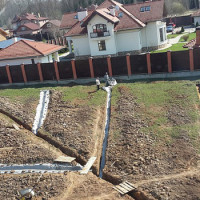 Do-it-yourself site drainage: features of the construction of various types of drainage
Do-it-yourself site drainage: features of the construction of various types of drainage 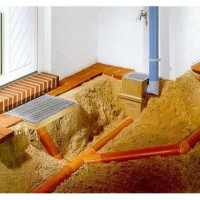 How to make your own foundation foundation drainage: step-by-step instruction on arrangement
How to make your own foundation foundation drainage: step-by-step instruction on arrangement 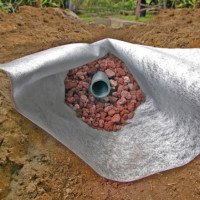 DIY drain pipe installation: step-by-step instruction + analysis of nuances
DIY drain pipe installation: step-by-step instruction + analysis of nuances 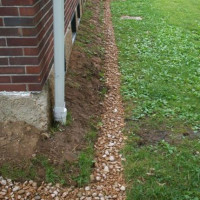 Wall drainage of the foundation: the specifics of the arrangement of the water drainage system
Wall drainage of the foundation: the specifics of the arrangement of the water drainage system  Drainage device around the house: design and installation of a drainage system with your own hands
Drainage device around the house: design and installation of a drainage system with your own hands  Site drainage project: selection of location, slope, depth, drainage system elements
Site drainage project: selection of location, slope, depth, drainage system elements  How much does it cost to connect gas to a private house: the price of organizing gas supply
How much does it cost to connect gas to a private house: the price of organizing gas supply  The best washing machines with dryer: model rating and customer tips
The best washing machines with dryer: model rating and customer tips  What is the color temperature of light and the nuances of choosing the temperature of the lamps to suit your needs
What is the color temperature of light and the nuances of choosing the temperature of the lamps to suit your needs  Replacement of a geyser in an apartment: replacement paperwork + basic norms and requirements
Replacement of a geyser in an apartment: replacement paperwork + basic norms and requirements
It seems everything is available. And on the Internet there is enough similar material. But as I look at the site ... in general, "the eyes are afraid." I have thirty acres, almost half in the spring it is flooding, especially after snowy winters. All think and wonder about the water drainage scheme. Here, after all, the material of the pipes must be selected so that it is not too expensive, but suitable, and all calculations should be made. In general, I do not know whether to save or entrust everything to professionals?
Good afternoon, Oleg. I would recommend that you first contact the construction organization for an individual project for the drainage of the site, taking into account all the features. Having already completed the full layout scheme, the number of required manholes, pipes, draw conclusions on how much it is possible to independently carry out all the work.
In any case, I advise you to order a project from specialists - this will save you from errors, and therefore from additional expenses in the future to eliminate them.
The fact that an open drainage system will cost much less than a closed execution is understandable. We started to build one in our own village, but a year later we decided to make a closed one, because I had to clean the canals of silt and leaves, and it takes up enough space. They put a plastic well and buried pipes, everything is fine now. The water settled in the collector well is discharged into our ravine.
And if there is nowhere to send water? Are the ditches silted or littered down the neighbor’s area? How then to be?
Good afternoon, Dmitry. The district administration or country association is responsible for the proper state of the ditches. I advise you to contact them in writing to fix the problem.
Fundamentally, the issue can be solved in two ways: by organizing one / two filtration wells on your site or by arranging a boundary around the perimeter, where to discharge the water. It is important to pay attention to the indicator of soil water absorption in a particular case. Simple definition methods are outlined in this article. You can familiarize yourself with the principles of arranging filtration wells. here.
The boundary is a ditch 20 to 20 cm wide; permission from neighbors or government bodies for its arrangement is not required. It is recommended to organize also in case of severe waterlogging of the site in the spring when snow melts.